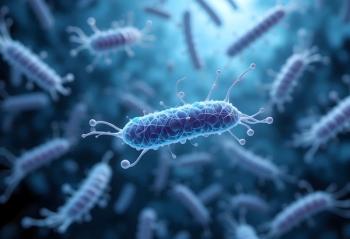
Results of the PUNCH CD3 Trial: RBX2660 in Recurrent CDI
Shared insight on the phase 3 data behind RBX2660, a novel FMT therapy for patients with recurrent Clostridioides difficile infection.
Episodes in this series

Transcript:
James A. McKinnell, MD: Let’s talk about the current phase 3 data. What are the phase 3 data out there that we should all be aware of?
Sahil Khanna, MBBS, MS: There are 2 trials that have finished phase 3 enrollment and have reported data. RBX2660 is an enema-based product derived from human stool. They take about 50 g of stool, which we all believe is probably the right dose to use. We take 50 g…in 150 cc of a…and it’s given by an enema-delivery methodology, very simple to do, no bowel preparation needed. There were phase 1 data that were positive, after 2 enemas, it was in the 87% range, then there was a phase 2 clinical trial that showed that, not 2, but 1 enema worked better than placebo. It was interesting why 2 didn’t work but 1 did, and after they had the open-label experience again, the cure rates were high in that situation. But those data were taken, and then a phase 3 large clinical trial was designed, which compared 1 dose of an active enema to 1 dose of a placebo.
Now, one thing to keep in mind is that these are patients with recurrent Clostridioides difficile infection, and they allowed people with 2 episodes in there, so people with 2 severe episodes were allowed in that trial. But again, keep in mind that when you have an active C diff infection, you don’t go to FMT [fecal microbiota transplantation] at that point. You first manage with antibiotics, kill the vegetative forms, decrease the colonic inflammation, and then the FMT reduces the rate of recurrence, and that’s how these trials were designed. For the RBX2660 trial, they also took advantage of a methodology called the Bayesian analysis because they had similar inclusion criteria for their phase 2 study, and multiply recurrent C diff with stringent criteria to enroll in clinical trials ends up being an orphan disease. Often you can’t find a lot of people to put in trials, so they took some patients from their phase 2 into the phase 3 when they did the final analysis; this was an a priori analysis that they had done. It was statistically significant, 70.5% cure rate from the active arm compared with 58%, and they had a posterior probability of superiority of 98.6%. It was statistically significant, clinically meaningful, but also, more importantly, no safety signals were seen.
The importance of these clinical trials is that you cut down on the heterogeneity. Meaning how I did FMT, from how Carl does it, and how you do it, and how other centers do it, everybody’s different. In order to reduce the heterogeneity, you want to have traceability of the product back to the donor in case there is any kind of an issue with an adverse event. All those things have been accounted for in many clinical trials that have a very rigorous donor program, but this is exciting. This was the first phase 3 trial that was reported positively, so I took a stab at that one. I’m going to have Kelly take a stab at the other one.
James A. McKinnell, MD: Before we jump into that, tell me a little bit more about RBX2660. What is it?
Sahil Khanna, MBBS, MS: It’s derived from human stool. It’s 50 g of stool from a donor who’s been screened for every possible pathogen. They get screened by the blood bank questionnaire, they have to pass that. They must screen travel, they have to screen pathogens, they have to screen for other diseases, no PPIs [protein pump inhibitors], no antibiotics, no depression, no anxiety, no obesity, no high blood pressure, the list goes on and on and on. There was a study that was done that showed that it’s easier to get into Harvard [University] than to be a stool donor, I like to quote that. It comes from healthy, very well screened donors who donate on-site. The product is then blenderized, filtered, and placed in enema bags, and it can be kept frozen. It’s shipped frozen, and then right before administration, it gets thawed to room temperature, and you give it through an enema administration.
James A. McKinnell, MD: As an ID [infectious disease] doctor, I don’t give enemas very often. How am I going to use this?
Sahil Khanna, MBBS, MS: As GI [gastroenterology] doctors, we like enemas.
James A. McKinnell, MD: Well, that was a fantastic quote. I hope we get to use that one. That’s great. You think this is relatively easy to administer?
Sahil Khanna, MBBS, MS: It’s relatively easy to administer. We’ve been able to train nurses to do this easily. Just to give you an example, we have nurses in our facility and other places too where we run what we call enema preparation facilities before procedures. People are used to giving others tap water, fleet enemas, which are much more difficult to do than this. This is simple. The patient would lie down on their left side, and you do a quick rectal examination to make sure there are no obvious obstructions or anything like that. There is an enema tubing that comes out of that enema bag, you lubricate it, you insert it about a couple of inches, and you hang the enema bag up and open it, and it flows in. It takes between 5 and 15 minutes depending on how high you hang it and how much gravity is working that day.
Most patients don’t even feel what’s happening. The majority of patients do not have any kind of leakage. It’s a very small volume, it’s about 5 oz. When people think of enemas, they’re like “Oh my god, is this the 32-oz enema I’m going to get that I got when I was constipated as a kid?” That’s not the case. This is the 5-oz enema, people are able to hold it in, and if you look at the age range of people who were in these studies, the majority of them were older people. There were some people in their 80s and 90s who’ve been in these studies, and no issues. People hold this in, you lie down for some time, and then you walk out, and that’s it.
James A. McKinnell, MD: Thank you for watching this HCPLive® Contagion® Peer Exchange. If you enjoyed the content, please subscribe to our e-newsletters to receive upcoming Peer Exchanges and other great content right in your inbox.
Transcript edited for clarity.
Newsletter
Stay informed on drug updates, treatment guidelines, and pharmacy practice trends—subscribe to Pharmacy Times for weekly clinical insights.

















































































































































































































